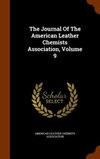Development of a Headspace-Solid Phase Micro Extraction Method for the Analysis of Volatile and Semi-Volatile Organic Compounds from Polyurethane Resins for Leather Finishing
IF 0.5
4区 工程技术
Q4 CHEMISTRY, APPLIED
Journal of The American Leather Chemists Association
Pub Date : 2021-08-02
DOI:10.34314/jalca.v116i8.4362
引用次数: 0
Abstract
Volatile organic compounds (VOCs) and Semi-Volatile Organic Compounds (SVOCs) arise from the chemicals used in the various stages of the leather manufacturing process. An important aim of the tanning industry is to minimize or eliminate VOCs and SVOCs, without lowering the quality of leather. This paper shows the development of a new headspace-solid phase micro extraction coupled with gas chromatography–mass spectrometry (HS-SPME/GC-MS) method for the identification of VOCs and SVOCs emitted by newly designed polymers for the leather finishing operation. These new polymers are polyurethane resins designed to reduce the VOC and SVOC concentration. This method enables a simple and fast determination of the qualitative and semi-quantitative content of VOCs and SVOCs in polyurethane-type finishing resins. The chemicals that are of concern in this paper are the following: Dipropylene glycol Monomethyl Ether (DPGME), DBE-3 (a mixture of dibasic esters) and Triethylamine (TEA). The test conditions that have been determined to carry out the HS-SPME assay are the following: incubation time (2 hours), extraction temperature and time (40°C; 5 minutes) and the desorption conditions (280°C, 50 seconds). Ten samples of laboratory scale resins were tested by HS-SPME followed by gas chromatography (GC-MS). DPGME and DBE-3 (a mixture of dimethyl adipate, dimethyl glutarate and dimethyl succinate) have been identified effectively. The compounds are identified by a quantitative method using external calibration curves for the target compounds. The technique is not effective to determine the TEA compound, since the chromatograms shown poor resolution peaks for the standard.顶空-固相微萃取法分析皮革整理用聚氨酯树脂中挥发性和半挥发性有机化合物的研究
挥发性有机化合物(VOCs)和半挥发性有机化合物(SVOCs)来自皮革制造过程中各个阶段使用的化学品。制革行业的一个重要目标是在不降低皮革质量的前提下,尽量减少或消除挥发性有机化合物和SVOCs。本文介绍了一种新的顶空固相微萃取-气相色谱-质谱联用(HS-SPME/GC-MS)方法,用于识别皮革涂饰过程中新设计的聚合物所排放的voc和SVOCs。这些新的聚合物是聚氨酯树脂,旨在降低VOC和SVOC浓度。该方法能够简单快速地测定聚氨酯型整理树脂中VOCs和SVOCs的定性和半定量含量。本文中涉及的化学物质有:二丙二醇单甲醚(DPGME)、DBE-3(二酸酯的混合物)和三乙胺(TEA)。已确定进行HS-SPME分析的测试条件如下:孵育时间(2小时),提取温度和时间(40°C;5分钟)和解吸条件(280°C, 50秒)。采用高效液相色谱-气相色谱-质谱联用技术(HS-SPME - GC-MS)对10个实验室水垢树脂样品进行了检测。DPGME和DBE-3(己二酸二甲酯、戊二酸二甲酯和琥珀酸二甲酯的混合物)已被有效地鉴定出来。利用目标化合物的外标曲线对化合物进行了定量鉴定。该技术不能有效地测定TEA化合物,因为色谱图显示出标准的低分辨率峰。
本文章由计算机程序翻译,如有差异,请以英文原文为准。
求助全文
约1分钟内获得全文
求助全文
来源期刊

Journal of The American Leather Chemists Association
工程技术-材料科学:纺织
CiteScore
1.30
自引率
33.30%
发文量
29
审稿时长
3 months
期刊介绍:
The Journal of the American Leather Chemists Association publishes manuscripts on all aspects of leather science, engineering, technology, and economics, and will consider related subjects that address concerns of the industry. Examples: hide/skin quality or utilization, leather production methods/equipment, tanning materials/leather chemicals, new and improved leathers, collagen studies, leather by-products, impacts of changes in leather products industries, process efficiency, sustainability, regulatory, safety, environmental, tannery waste management and industry economics.
 求助内容:
求助内容: 应助结果提醒方式:
应助结果提醒方式:


